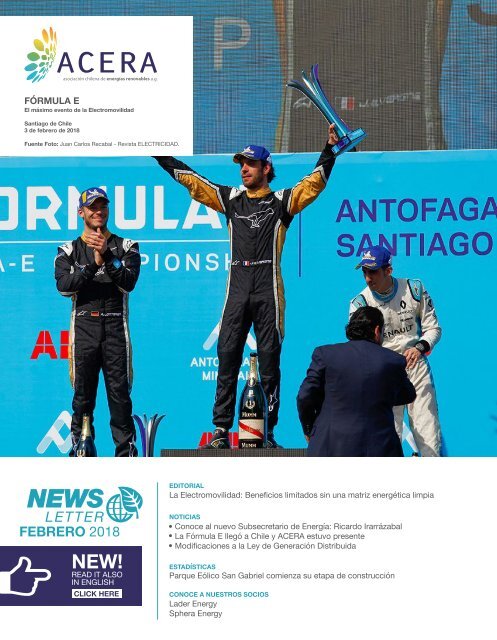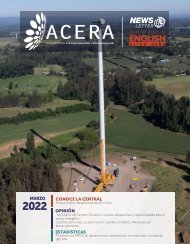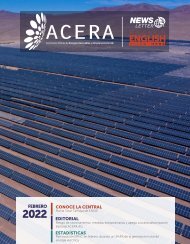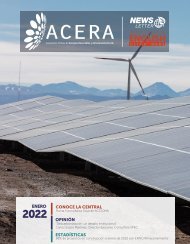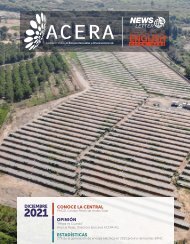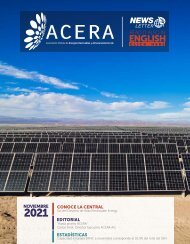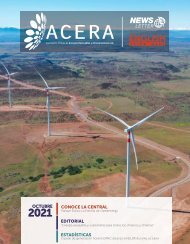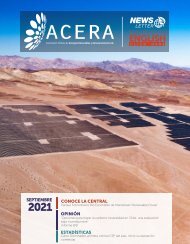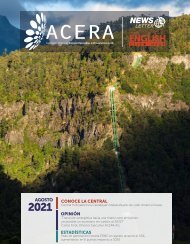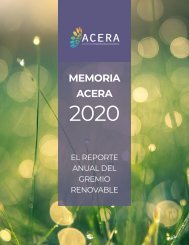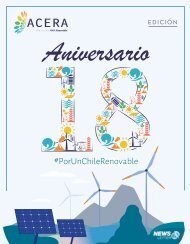Newsletter ACERA - Febrero 2018
You also want an ePaper? Increase the reach of your titles
YUMPU automatically turns print PDFs into web optimized ePapers that Google loves.
FÓRMULA E<br />
El máximo evento de la Electromovilidad<br />
Santiago de Chile<br />
3 de febrero de <strong>2018</strong><br />
Fuente Foto: Juan Carlos Recabal - Revista ELECTRICIDAD.<br />
EDITORIAL<br />
La Electromovilidad: Beneficios limitados sin una matriz energética limpia<br />
FEBRERO <strong>2018</strong><br />
NEW!<br />
READ IT ALSO<br />
IN ENGLISH<br />
CLICK HERE<br />
NOTICIAS<br />
Conoce al nuevo Subsecretario de Energía: Ricardo Irarrázabal<br />
La Fórmula E llegó a Chile y <strong>ACERA</strong> estuvo presente<br />
Modificaciones a la Ley de Generación Distribuida<br />
ESTADÍSTICAS<br />
Parque Eólico San Gabriel comienza su etapa de construcción<br />
CONOCE A NUESTROS SOCIOS<br />
Lader Energy<br />
Sphera Energy
EDITORIAL<br />
Darío Morales<br />
Director de Estudios<br />
<strong>ACERA</strong> AG.<br />
La Electromovilidad: Beneficios limitados sin una matriz energética limpia<br />
Un antiguo refrán dice: “lo obvio por sabido se calla, y por<br />
callado se olvida”.<br />
A raíz de la última fecha de la Fórmula E, llevada a cabo en<br />
Santiago a comienzos de febrero, mucho se ha dicho sobre los<br />
beneficios de la movilidad eléctrica, pero poco se refuerza que<br />
para que Chile aproveche al máximo estos beneficios, es<br />
fundamental contar con una matriz eléctrica limpia.<br />
Un estudio realizado por el International Council on Clean<br />
Transportation (ICCT) sobre las emisiones durante el ciclo de<br />
vida de un auto eléctrico, afirma que con el mix eléctrico que<br />
hoy tiene Europa, un vehículo eléctrico reduce las emisiones en<br />
un 30% con respecto al auto a combustión más eficiente y en<br />
un 50% con respecto al auto a combustión promedio que<br />
circula por ese continente.<br />
Lo interesante es que el estudio, además, descompone los<br />
aportes de emisiones durante las etapas de fabricación y de<br />
operación de cada tecnología. Si bien se afirma que durante el<br />
proceso de fabricación de un auto eléctrico éstas son mayores<br />
a las de un auto convencional, es claro que por concepto de<br />
operación son menores. Sin embargo, no hay que olvidar que<br />
estas últimas dependen casi exclusivamente del factor de<br />
emisión de la electricidad que lo alimenta. Según este estudio,<br />
al compararlo con un auto convencional, uno eléctrico puede<br />
reducir las emisiones en un rango que va “desde un 28% hasta<br />
un 72% dependiendo del mix de generación eléctrica local”.<br />
Algo similar se expone en el artículo escrito por investigadores<br />
de la Universidad de Tsinghua en China y el Argonne National<br />
Laboratory en EEUU (Hong Huo, et al.), publicado por la revista<br />
científica Astmospheric Environment en 2015. La hipótesis del<br />
artículo es que, dado que el auto eléctrico disminuye la<br />
demanda de combustibles fósiles, pero aumenta la demanda<br />
por energía eléctrica, los beneficios ambientales netos de la<br />
electromovilidad dependerán principalmente de la composición<br />
de la matriz eléctrica. Clave no olvidar.<br />
“Los vehículos eléctricos operando en regiones donde el<br />
carbón domina el mix energético, podrían incluso aumentar las<br />
emisiones o en el mejor de los casos limitar fuertemente sus<br />
beneficios”. De igual forma exponen que “en lugares donde un<br />
auto elécrtrico sea cargado con un 80% de electricidad<br />
renovable, podrían reducir los gases de efecto invernadero en<br />
más de un 85%, disminuir el SO2 y NOx en más de un 75% y el<br />
material particulado en más de un 40%”.<br />
En definitiva, no cabe duda de que debemos caminar hacia la<br />
movilidad eléctrica, pero no hay que olvidar que ésta no es un<br />
fin por sí misma, sino más bien una herramienta para que Chile<br />
pueda avanzar en el camino del desarrollo sustentable, y para<br />
lo anterior es un requisito fundamental contar con un suministro<br />
eléctrico limpio. Otro desafío para alcanzar un Chile 100%<br />
Renovable.
NOTICIAS<br />
CONOCE AL NUEVO SUBSECRETARIO DE ENERGÍA:<br />
RICARDO IRARRÁZABAL<br />
Fuente foto: SebastianPiñera.cl<br />
Fueron muchos los nombres que trascendieron para estar a la cabeza de las Subsecretarías<br />
Ministeriales, pero fue el Presidente electo, Sebastián Piñera, quien dio fin a las<br />
especulaciones, nombrando -a través de una inédita transmisión por redes sociales- la lista<br />
de las y los subsecretarios que asumirán el próximo 11 de marzo. De los 35 nombres que<br />
lo acompañarán en su futura administración, ¡ÉSTA una parte ES LA pertenece PRIMERA a la PLANTA coalición de Chile<br />
Vamos y más de la mitad trabajó con él en GEOTÉRMICA su gobierno anterior. DE SUDAMÉRICA!<br />
Es justamente ese el<br />
escenario de la cartera de Energía, donde será el abogado Ricardo Irarrázabal, quien se<br />
desempeñó como Subsecretario del Medio Ambiente en el primer gobierno de Piñera,<br />
quien asumirá el puesto.<br />
Irarrázabal es abogado de la Pontificia Universidad Católica de Chile, Diplomado en<br />
Derecho de los Recursos Naturales de la misma Universidad (2003), Magíster en Derecho<br />
por el Centre for Energy, Petroleum & Mineral Law & Policy de la Universidad de Dundee,<br />
Escocia, y becario Chevening en el mismo programa (2005). Fue socio ambiental en el<br />
estudio jurídico Arteaga Gorziglia (2014-2017), director ejecutivo del Servicio de Evaluación<br />
Ambiental (2013 – 2014), subsecretario del Ministerio de Medio Ambiente (2010 – 2013),<br />
abogado en Philippi, Yrarrázaval, Pulido & Brunner (2001 – 2003 y 2007-2009), Ashurst<br />
(2006), McMillan (2006) y Uría & Menéndez (2004), entre otras experiencias profesionales.<br />
Para revisar las otras subsecretarías, puedes visitar la web del Presidente electo: ACÁ.<br />
LA FÓRMULA E LLEGÓ A CHILE Y <strong>ACERA</strong> ESTUVO PRESENTE<br />
La Federación Internacional de Automovilismo (FIA) es conocida mundialmente por la<br />
Fórmula 1, sin embargo, ha sido otra la carrera que se ha robado todas las miradas en<br />
el último tiempo, especialmente las de nuestro país: La Fórmula E. Esta carrera es la<br />
última apuesta de la FIA, competencia con la que busca alinearse con la preocupación<br />
mundial por el cuidado del medio ambiente.<br />
La “E” de su nombre corresponde a “Electrónica”, que deriva de la utilización exclusiva<br />
de vehículos con motorización electrónica para la competencia. La serie -que<br />
comenzó en 2014- tuvo su oportunidad en Chile por primera vez el pasado 3 de<br />
febrero, finalizando con los pilotos de Techeetah en el podio, Jean-Eric Vergne<br />
(Francia) en el primer lugar y Andre Lotterer (Alemania) en el segundo.<br />
Fuente foto: Juan Carlos Recabal<br />
Revista ELECTRICIDAD<br />
<strong>ACERA</strong> también está interesada en promover la incorporación de los automóviles<br />
eléctricos para Chile, ya que será un aporte clave para la mitigación del cambio<br />
climático y la descontaminación local, pero también es importante que su desarrollo<br />
esté acompañado de una matriz eléctrica renovable que respalde esta nueva<br />
tecnología para que cumpla sus objetivos. Es por esto y más que <strong>ACERA</strong>, como la<br />
Asociación que reúne a todo el sector ERNC en Chile, además de ser uno de los<br />
impulsores de la electromovilidad, no podía estar ausente de este importante evento y<br />
participó activamente de la carrera como uno de los auspiciadores en la transmisión<br />
del evento.<br />
Revisa la carrera completa ACÁ.
TU EMPRESA<br />
PODRÍA ESTAR<br />
AQUÍ<br />
MEDIA PÁGINA HORIZONTAL<br />
Contacto<br />
Paula Vicens<br />
paula.vicens@acera.cl<br />
+562 22363348
NOTICIAS<br />
MODIFICACIONES A LA LEY DE GENERACIÓN DISTRIBUIDA<br />
El 9 de enero, por unanimidad, se aprobó en el Senado, en primer trámite constitucional, el<br />
proyecto de ley que modifica la ley N° 20.571, de generación distribuida, también conocida<br />
como Net-billing. El proyecto de ley pasó a la Cámara de Diputados en segundo trámite<br />
constitucional, acogiendo parte de las modificaciones propuestas por una moción<br />
parlamentaria.<br />
¡ÉSTA ES LA PRIMERA PLANTA<br />
GEOTÉRMICA DE SUDAMÉRICA!<br />
En la instancia se aprobaron los siguientes cambios planteados por el Ministerio de Energía:<br />
a) Subir el límite de capacidad instalada de los generadores desde 100 kW a 300 kW, para<br />
apoyar el desarrollo de proyectos de autoconsumo mayores, que benefician principalmente<br />
a actividades productivas, y; b) Reforzar que la Ley tiene por objetivo el fomento al<br />
autoconsumo y no la comercialización de la energía, la que tiene otro marco regulatorio<br />
(PMGD). Para ello se establece que los excedentes que, eventualmente, después de un<br />
tiempo prolongado, por ejemplo, uno o más años, no pudiesen descontarse de la cuenta de<br />
electricidad del establecimiento en el que está instalado el sistema de generación, puedan<br />
descontarse de cuentas de suministro eléctrico de otros establecimientos del mismo<br />
propietario (mismo RUT) y para la misma empresa distribuidora. Si no tuviese otras cuentas,<br />
lo que no haya podido descontarse no se pierde, sino que se acumula.<br />
Al respecto, <strong>ACERA</strong> considera que el proyecto en general es positivo y necesario. Sin<br />
embargo, la manera de reforzar el carácter de autoconsumo debe ser mejorada, evitando<br />
limitar que los generadores residenciales puedan hacer efectivos los pagos que les<br />
corresponden por sus inyecciones. En consecuencia a lo anterior, la Asociación presentará<br />
sus comentarios al Ministerio de Energía y al Congreso en marzo de este año.<br />
Fuente: Ministerio de Energía<br />
<strong>ACERA</strong> Y GIZ PRESENTAN SEMINARIO SOBRE RELACIONAMIENTO<br />
COMUNITARIO EN PROYECTOS ENERGÉTICOS<br />
Desde 2014, se ha observado un significativo aumento en la generación eléctrica<br />
con energías renovables llegando a constituir un 44% de la potencia instalada de la<br />
matriz. Este crecimiento implica la incorporación activa de comunidades, como<br />
pieza clave en el desarrollo del sector e incluso hacia las metas del cambio climático.<br />
¿Cómo iniciar un proceso de inclusión? ¿Qué elementos considerar? ¿Cómo lograr<br />
un acercamiento? Para dar respuesta a estas interrogantes y presentar casos de<br />
éxito, es que el Ministerio de Energía, GIZ y <strong>ACERA</strong> organizaron el Seminario<br />
“Relacionamiento Comunitario en proyectos energéticos: Estrategias y<br />
Herramientas”, centrado en la presentación de metodologías y herramientas que<br />
fortalecen y apoyan el Relacionamiento Comunitario.<br />
La jornada estuvo encabezada por la Subsecretaria de Energía, Jimena Jara,<br />
quien además de referirse a la situación energética nacional, explicó que “en materia<br />
de participación, el Ministerio ha impulsado tres elementos: una Guía de Estándares<br />
de Participación, que se ha utilizado en más 50 proyectos energéticos. Un capítulo<br />
indígena en la Política Energética 2050, que incluyó la participación de los 9 pueblos<br />
originarios reconocidos en Chile y, por último, una política de desarrollo local<br />
sostenible y asociativo que promueve que el Estado, empresas y comunidades<br />
coordinen el desarrollo local”.
21 al 23 de Noviembre de <strong>2018</strong><br />
Santiago Business & Conference Center, Santiago, Chile<br />
Contrate hoy su Stand o<br />
sea Auspiciador de uno de<br />
los encuentros de energías<br />
renovables más importantes<br />
del hemisferio sur<br />
Chile es<br />
único<br />
en su variedad y cantidad de<br />
recursos para energías<br />
renovables<br />
19%<br />
de representatividad<br />
en la matriz y<br />
generando el<br />
16%<br />
de la energía<br />
Top 10<br />
de los países más atractivos<br />
para invertir en<br />
ERNC<br />
Rol<br />
fundamental en la<br />
baja de<br />
precios<br />
Para más información<br />
y ventas contácte a:<br />
Las<br />
ERNC<br />
son un factor clave de<br />
mitigación del cambio<br />
climático<br />
Cintya Font: cfont@editec.cl<br />
+56 2 2757 4281<br />
www.expoernc.cl<br />
ORGANIZAN<br />
MEDIO OFICIAL AUSPICIADOR GOLD AUSPICIADORES SOCIALES
ESTADÍSTICAS<br />
PARQUE EÓLICO SAN GABRIEL COMIENZA SU ETAPA DE CONSTRUCCIÓN<br />
Durante el mes de febrero de <strong>2018</strong>, el Servicio de Evaluación Ambiental aprobó tres proyectos ERNC, sumando 22,3 MW.<br />
Por otra parte, cuatro proyectos ERNC fueron admitidos a calificación durante este mes, totalizando 156 MW, destacándose un proyecto eólico<br />
de 138 MW.<br />
En la resolución exenta número 160 del 23 de febrero de <strong>2018</strong>, publicada por la CNE, seis proyectos ERNC fueron declarados en construcción,<br />
sumando 213 MW, destacándose el Parque Eólico San Gabriel de la empresa Acciona (183 MW).<br />
Además, el documento anunció que un proyecto ERNC Mini-Hidro, de 2,7 MW entró en periodo de pruebas.<br />
PROYECTOS ERNC POR ESTADO DE AVANCE<br />
12.000<br />
10.000<br />
Tipo de Tecnología<br />
Potencia (MW)<br />
En operación En construcción Aprobado En calificación Total<br />
8.000<br />
Energía Eólica<br />
1.539<br />
558<br />
6.672<br />
1.628<br />
10.397<br />
6.000<br />
Solar PV<br />
CSP<br />
2.274<br />
0<br />
189<br />
110<br />
14.318<br />
2.192<br />
4.787<br />
0<br />
21.568<br />
2.302<br />
4.000<br />
2.000<br />
0<br />
Energía Eólica Solar PV CSP Bioenergía Geotérmica Mini hidro ERNC PSH Termosolar<br />
Bioenergía<br />
Geotérmica<br />
Mini hidro ERNC<br />
PSH (Pumped<br />
storage hydro)<br />
Termosolar<br />
Total<br />
482<br />
48<br />
622<br />
0<br />
0<br />
0<br />
70<br />
0<br />
217<br />
70<br />
335<br />
300<br />
30<br />
50<br />
90<br />
0<br />
729<br />
168<br />
1.117<br />
300<br />
39 0 0 1.200 1.239<br />
5.004<br />
927 24.104 7.785 37.820<br />
Potencia de proyectos en operación (MW)<br />
Potencia de proyectos aprobados (MW)<br />
Potencia de proyectos en construcción (MW)<br />
Potencia de proyectos en calificación (MW)<br />
POTENCIA ERNC INSTALADA Y EN CONSTRUCCIÓN POR SISTEMA<br />
Potencia instalada SIC (MW)<br />
Potencia instalada SING (MW)<br />
Mini hidro ERNC 576<br />
Solar PV 1.557<br />
Mini hidro ERNC<br />
Solar PV<br />
16<br />
680<br />
Energía Eólica<br />
1.330<br />
Energía Eólica<br />
202<br />
Bioenergía<br />
482<br />
Geotérmica<br />
48<br />
Potencia en construcción SIC (MW)<br />
Potencia en construcción SING (MW)<br />
Mini hidro ERNC<br />
70<br />
Solar PV<br />
108<br />
Solar PV<br />
70<br />
CSP<br />
110<br />
Energía Eólica<br />
558<br />
Geotérmica<br />
Energía Eólica<br />
Solar PV CSP Bioenergía Geotérmica Mini Hidro
ESTADÍSTICAS<br />
Durante enero de <strong>2018</strong>, las ERNC aportaron el 17,82% de la energía total del sistema.<br />
La energía solar fue la que más contribuyó con un 7,21%, lo que significó una disminución del 0,15% con respecto a la generación del mes anterior.<br />
Le siguió la energía eólica con un 4,32%, aumentando un 4,8% con respecto al mes de diciembre de 2017.<br />
La energía proveniente de la bioenergía estuvo en tercer lugar con 3,11%, representando un aumento del 22,87% respecto al mes anterior. A<br />
continuación, estuvo la energía proveniente de centrales mini-hidro, con un 2,87%, con un decremento del 12,27% con respecto a diciembre<br />
de 2017.<br />
Finalmente, estuvo la energía geotérmica que contribuyó con un 0,3%, lo que significó un aumento del 629,8% con respecto a la generación del<br />
mes anterior.<br />
PORCENTAJE DE PARTICIPACIÓN DE LAS ERNC EN EL SISTEMA<br />
20%<br />
18%<br />
16%<br />
14%<br />
12%<br />
10%<br />
8%<br />
6%<br />
4%<br />
2%<br />
2012 2013 2014 2015 2016 feb.17 mar.17 abr.17 may.17 jun.17 jul.17 ago.17 sep.17 oct.17 nov.17 dic.17 ene.18<br />
Solar Eólico Bioenergía Mini Hidro Geotermia Total Reconocido Obligación<br />
Porcentaje de participación ERNC Enero <strong>2018</strong> <strong>2018</strong> YTD<br />
Reconocido<br />
*<br />
Obligación<br />
*<br />
Bioenergía 3,11%<br />
Eólica<br />
4,32%<br />
Hidraúlica<br />
2,87%<br />
Geotérmica<br />
0,30%<br />
Solar<br />
7,21%<br />
*<br />
*<br />
3,11%<br />
4,32%<br />
2,87%<br />
0,30%<br />
7,21%<br />
* Al 5 de marzo de <strong>2018</strong>, la información destacada no estaba disponible<br />
en el sitio del Coordinador Eléctrico Nacional.<br />
La información de éste gráfico está desfasada en dos meses.<br />
Total<br />
17,82% 17,82%<br />
Fuente de gráficos: Elaboración propia en base a información de CNE, Coordinador Eléctrico Nacional y SEIA.
CONOCIENDO A NUESTROS SOCIOS<br />
Horacio Vásquez<br />
SOCIO FUNDADOR<br />
hvasquez@laderenergy.com<br />
Horacio es chileno, Ingeniero Industrial de la Universidad Federico Santa<br />
María, emprendedor de distintos negocios en los rubros de energías<br />
renovables y tecnología. Cuenta con más de 10 años de experiencia en<br />
renovables en más de seis países de LATAM.<br />
¿Cuáles son los productos o servicios que entrega su empresa y hacia qué tipo(s)<br />
de ERNC?<br />
Somos una empresa especializada en el desarrollo de proyectos de energías<br />
renovables, solar y eólico, específicamente. Estamos enfocados principalmente<br />
en Argentina, Colombia y Chile, contando con un portafolio de proyectos de casi<br />
1 GW.<br />
¿Cuáles son las novedades o cambios de su empresa en el último tiempo?<br />
Entre 2016 y 2017 nos adjudicamos dos proyectos solares (180 MWn) en las<br />
licitaciones de Argentina, país donde hemos iniciado la construcción de un<br />
proyecto que -además- está cercano a lograr el primer Project Finance Solar de<br />
ese país. En Chile, nos adjudicamos un concurso Corfo para desarrollar un<br />
Sistema de Monitoreo y Mantenimiento Predictivo con Inteligencia Artificial para<br />
Parques Solares. Actualmente, estamos implementando el primer piloto.<br />
¿Cuáles son los principales proyectos -o temas- que están trabajando en el<br />
último tiempo en torno a las ERNC o el medioambiente? En caso de ser plantas<br />
de generación, ¿dónde se ubican? ¿Cuáles son sus características centrales?<br />
Estamos trabajando en los dos proyectos solares en Argentina, además de 200<br />
MW en Colombia. En Chile, estamos enfocados en el desarrollo del Sistema de<br />
Mantenimiento Predictivo con Inteligencia Artificial y la implementación exitosa de<br />
nuestro primer piloto. Finalmente, estamos avanzando en el desarrollo de un<br />
proyecto tecnológico de limpieza de módulos solares, que reduzca<br />
considerablemente el uso de agua, tiempos y costos.<br />
¿Qué elementos caracterizan y/o diferencian a su empresa?<br />
Somos una empresa con un equipo de amplia experiencia, con más de 10 años<br />
en el negocio de las energías renovables en LATAM. Nuestro enfoque está en la<br />
calidad, innovación y pasión por lo que hacemos, contando con la confianza de<br />
nuestros clientes.<br />
¿Cuál considera que es la importancia de la participación ERNC en el sistema<br />
eléctrico del país?<br />
La penetración ERNC en Chile ha sido muy importante en los últimos años y lo<br />
seguirá siendo en el futuro, logrando reducir los costos de la energía, haciendo de<br />
Chile un país más competitivo. Además, se genera una mayor independencia<br />
energética, desplazando el uso de combustibles fósiles por energía limpia y<br />
sustentable.<br />
¿Por qué recomendaría ser socio de <strong>ACERA</strong>?<br />
Recomendaría <strong>ACERA</strong>, sin duda, porque ha sido una asociación que ha aportado<br />
fuertemente en el desarrollo y las políticas necesarias para la incorporación de las<br />
energías renovables en el país, convirtiéndose en referentes en todo LATAM.<br />
Carlos Cabrera<br />
MANAGING PARTNER<br />
ccabrera@spheraenergy.com<br />
Carlos es chileno-venezolano, vive hace más de 20 años en Chile y tiene un<br />
hijo de 10 años. Es Ingeniero Civil Eléctrico (USACH), Diploma en Mercado<br />
Eléctrico y Regulación (Universidad de Chile) y Profesor del diplomado<br />
Mercado Eléctrico y Regulación impartido por el DIE de la USACH.<br />
¿Cuáles son los productos o servicios que entrega su empresa y hacia qué tipo(s)<br />
de ERNC?<br />
Sphera Energy nace como una empresa desarrolladora de proyectos PMGDs y<br />
luego evoluciona hacia la prestación de servicios de consultorías 360º en todos<br />
los aspectos requeridos para el desarrollo de proyectos PMGDs, con especial<br />
énfasis en procesos de compra venta de activos y “Due Diligence”.<br />
¿Cuáles son las novedades o cambios de su empresa en el último tiempo?<br />
Sumado al desarrollo de proyectos PMGDs y a la prestación de asesorías<br />
estratégicas, durante el 2017 hemos abierto tres líneas nuevas de productos y<br />
servicios: (i) Proyectos de generación distribuida (net billing), (ii) sistemas de<br />
almacenamiento a través de Baterías (BESS), y (iii) proyectos de electromovilidad<br />
con puntos de carga y arriendo de vehiculos eléctricos.<br />
¿Cuáles son los principales proyectos -o temas- que están trabajando en el<br />
último tiempo en torno a las ERNC o el medioambiente? En caso de ser plantas<br />
de generación, ¿dónde se ubican? ¿Cuáles son sus características centrales?<br />
Durante 2017 cerramos la venta de nuestro primer paquete de 4 proyectos<br />
PMGDs. El primer proyecto se encuentra en operación, el segundo en fase de<br />
pruebas y los siguientes entrarán en operación en <strong>2018</strong>. Adicionalmente, estamos<br />
enfocados en el desarrollo de proyectos de generación distribuida a través de<br />
modelos ESCOs y potenciando la penetración de sistemas BESS en Chile. De<br />
hecho, estamos cerrando los acuerdos para nuestro primer proyecto de 100 kW<br />
(ampliable a 300 kW) que esperamos tener operando en el 3Q-<strong>2018</strong>.<br />
¿Qué elementos caracterizan y/o diferencian a su empresa?<br />
Somos un Desarrollador/Consultor boutique que se enfoca en un conjunto<br />
acotado de proyectos y clientes, buscando ofrecer altos estándares y la mayor<br />
calidad posible en nuestros productos y servicios. Ofrecemos un gran<br />
conocimiento y experiencia en el mercado eléctrico y un soporte estratégico<br />
permanenente a nuestros clientes/inversionistas.<br />
¿Cuál considera que es la importancia de la participación ERNC en el sistema<br />
eléctrico del país?<br />
Estamos convencidos de que las ERNC seguirán siendo parte importante del<br />
crecimiento del mercado eléctrico en Chile y en el mundo. En particular, los<br />
proyectos de menor escala y generación distribuida, acompañarán la mayor<br />
electrificación de nuestra matriz energética y serán repotenciadas con sistemas<br />
de almacenamiento cada vez más eficientes y modulares.<br />
¿Por qué recomendaría ser socio de <strong>ACERA</strong>?<br />
Nos parece un gremio bastante diversificado en términos de tecnologías,<br />
tamaños de empresas y tipos de servicios. Esto permite recoger las necesidades<br />
y visiones de todos los actores presentes para el éxito de un proyecto, desde su<br />
concepción hasta su ejecución, y posterior operación. Lo anterior se suma a la<br />
participación activa del gremio en los cambios regulatorios y de mercado<br />
requeridos para dar un marco claro y participativo del desarrollo sustentable de<br />
nuestro país.
MEET OUR MEMBERS<br />
Horacio Vásquez<br />
FOUNDING PARTNER<br />
hvasquez@laderenergy.com<br />
Horacio is Chilean, an Industrial Engineer from the Federico Santa María<br />
University, and an entrepreneur of different businesses in the renewable<br />
energies and technology areas. He has over 10 years of experience in<br />
renewable energies in more than six countries of Latin America.<br />
What products or services does your company deliver and to what kind(s) of<br />
NCREs?<br />
We are a company specialized in the development of renewable energy projects,<br />
specifically solar and wind. We are mainly focused in Argentina, Colombia and<br />
Chile, with a project portfolio of almost 1 GW.<br />
Which have been the latest new services or changes introduced by your<br />
Company?<br />
During 2016 and 2017 we were awarded two solar projects (180MWn) in tenders<br />
in Argentina, where we have begun the construction of a Project which is about to<br />
achieve the first Solar Project Finance of that country. In Chile, we were awarded<br />
a Corfo contest to develop a Monitoring and Predictive Maintenance System with<br />
Artificial Intelligence for Solar Farms. We are currently implementing the first pilot.<br />
What are the main projects -or themes- you have been recently working on<br />
concerning NCRE or the environment? In case they are generation plants, where<br />
are the located and which are their main characteristics?<br />
We are working on two solar projects in Argentina, and a 200 MW Project in<br />
Colombia. In Chile, we are focused on the development of the Predictive<br />
Maintenance System with Artificial Intelligence and the implementation of our first<br />
pilot. Finally, we are making progress in the development of a technological<br />
project to clean solar modules, that would reduce considerably the use of water,<br />
time and costs.<br />
Which elements characterize and/or distinguish your company?<br />
Our company has a widely experienced team with over 10 years in the business<br />
of renewable energies in Latin America. Our focus is the quality, innovation, and<br />
passion for what we do, and our customers trust us.<br />
How important is NCRE participation in the Chilean electric system?<br />
NCRE’s penetration in Chile has been very important in the last few years and will<br />
continue being so in the future, with the consequent reduction in energy costs,<br />
which will make Chile a more competitive country. In addition, it generates an<br />
increase in energy independence, leaving aside the use of fossil fuels for clean<br />
and sustainable energy.<br />
Why would you recommend being an <strong>ACERA</strong> member?<br />
I would certainly recommend <strong>ACERA</strong> since it has been an Association that has<br />
contributed significantly to the development and the policies required for the<br />
introduction of renewable energies in the country, becoming a referent in all Latin<br />
America.<br />
Carlos Cabrera<br />
MANAGING PARTNER<br />
ccabrera@spheraenergy.com<br />
Carlos is Chilean-Venezuelan, has lived for over 20 years in Chile and has one<br />
son aged 10. He is an Electrical Civil Engineer (USACH), with a Degree in<br />
Electrical Market and Regulation (Universidad de Chile), and Professor of the<br />
Electrical Market and Regulation Diploma Course offered by the Department<br />
of Electric Engineering (DIE) of Universidad de Santiago de Chile (USACH).<br />
What products or services does your company deliver and to what kind(s) of<br />
NCREs?<br />
Sphera Energy was born as a PMGD projects developing company and<br />
subsequently evolved towards 360-degree assessment services in all aspects<br />
required for the development of PMGD projects, emphasizing especially in<br />
processes of purchase and sale of assets, and Due Diligence.<br />
Which have been the latest new services or changes introduced by your<br />
Company?<br />
In addition to the development of PMGD projects and the provision of strategic<br />
advice, during 2017 we opened two new lines of products and services:<br />
Distributed generation projects (net billing) and BESS.<br />
What are the main projects -or themes- you have been recently working on<br />
concerning NCRE or the environment? In case they are generation plants, where<br />
are the located and which are their main characteristics?<br />
During 2017 we closed the sale of our first package of PMGD projects. The first<br />
one is in operation, the second one is being tested, and the other ones will start<br />
operating in <strong>2018</strong>. We are also focused on the development of distributed<br />
generation projects through ESCO models, and enhancing the penetration of<br />
BESS systems in Chile.<br />
Which elements characterize and/or distinguish your company?<br />
We are a boutique Developer/Consultant, focused on a limited number of projects<br />
and customers, looking forward to offering high standards and the maximum<br />
possible quality in our products and services. We offer a thorough knowledge and<br />
experience in the electric market, and a permanent strategic support to our<br />
customers/investors.<br />
How important is NCRE participation in the Chilean electric system?<br />
We are certain that NCREs will continue to be an important part of the electric<br />
market growth in Chile and worldwide. In particular, the increase of our power<br />
matrix electrification will give rise to smaller-scale and distributed generation<br />
projects, which will be re-enhanced by more efficient and modular storage<br />
systems.<br />
Why would you recommend being an <strong>ACERA</strong> member?<br />
We believe it is a quite diversified guild in terms of technologies, size of<br />
companies, and kinds of services, which allow gathering the requirements and<br />
views of all the present actors for the success of a project, from its conception to<br />
its execution and further operation. In addition, <strong>ACERA</strong> plays an active role in the<br />
regulatory and market changes required for a clear and participatory framework of<br />
the sustainable development of our country.
EVENTOS<br />
MARZO<br />
EVENTOS DEL MES<br />
14<br />
al<br />
16<br />
Congreso Latino Americano de Energías Renovables<br />
Arena International Events Group<br />
Buenos Aires - Argentina<br />
Revisar aquí<br />
21<br />
RENPOWER PERÚ Conferencia de inversionistas en<br />
energías renovables e infraestructura eléctrica<br />
Euroconvention Global<br />
Lima - Perú<br />
Revisar aquí<br />
<strong>2018</strong><br />
EVENTOS DEL AÑO<br />
ABRIL<br />
03 al04<br />
04 al05<br />
10<br />
10al12<br />
11<br />
19 al 21<br />
23 al 27<br />
LatAm Energy Forum <strong>2018</strong><br />
Latam B2B Events<br />
Santiago - Chile<br />
Revisar aquí<br />
2do Encuentro Internacional de Energías Renovables<br />
World Energy Council<br />
Barranquilla - Colombia<br />
Revisar aquí<br />
Cena Anual de las Energías Renovables<br />
<strong>ACERA</strong><br />
Santiago - Chile<br />
Revisar aquí<br />
CIREC Week<br />
CIREC<br />
Santiago - Chile<br />
Revisar aquí<br />
Cena Cesco <strong>2018</strong><br />
CESCO<br />
Santiago - Chile<br />
Revisar aquí<br />
Elecgrama y ChangeXChange <strong>2018</strong><br />
IEEMA<br />
Delhi NCR - India<br />
Revisar aquí<br />
XV Congreso Internacional Expomin <strong>2018</strong><br />
FISA<br />
Santiago - Chile<br />
Revisar aquí
EVENTOS<br />
<strong>2018</strong><br />
EVENTOS DEL AÑO<br />
MAYO<br />
08 al 09<br />
16<br />
16<br />
22 al 24<br />
El Futuro Solar<br />
Solar Plaza<br />
Buenos Aires - Argentina<br />
Revisar aquí<br />
Cena de la Ingeniería<br />
Colegio de Ingenieros<br />
Santiago - Chile<br />
Revisar aquí<br />
Elecgas <strong>2018</strong><br />
Technopress (Editec)<br />
Santiago - Chile<br />
Revisar aquí<br />
EnerSolar + Brasil <strong>2018</strong><br />
CIPA Fiera Milano<br />
São Paulo - Brasil<br />
Revisar aquí<br />
31 de mayo al<br />
02 de junio<br />
ExpoSolar Colombia <strong>2018</strong><br />
ExpoSolar Colombia<br />
Medellín - Colombia<br />
Revisar aquí<br />
JUNIO<br />
05<br />
Chile Energy & Infrastructure Finance Forum <strong>2018</strong><br />
IjGlobal<br />
Santiago - Chile<br />
Revisar aquí<br />
JULIO<br />
10 al 11<br />
11<br />
25<br />
Investing in Latam Mining Cumbre<br />
Euromoney Trading Ltd<br />
Santiago - Chile<br />
Revisar aquí<br />
ForoSur <strong>2018</strong><br />
Technopress (Editec)<br />
Concepción - Chile<br />
Revisar aquí<br />
Disruptors and energy transition forum<br />
Institute of The Americas<br />
Santiago - Chile<br />
Revisar aquí
¡ÉSTA ES LA PRIMERA PLANTA<br />
GEOTÉRMICA DE SUDAMÉRICA!<br />
<strong>ACERA</strong>, Asociación Chilena de<br />
Energías Renovables A.G.<br />
General del Canto 230, Of 601<br />
Providencia, Santiago<br />
+562 2236 3348<br />
informaciones@acera.cl<br />
@<strong>ACERA</strong>AG<br />
<strong>ACERA</strong>
FÓRMULA E<br />
The maximum event of Electromobility<br />
Santiago, Chile<br />
February 3, <strong>2018</strong><br />
Source of Photo: Juan Carlos Recabal – ELECTRICIDAD Magazine.<br />
EDITORIAL<br />
Electromobility: limited benefits without a clean energy matrix<br />
NEWS<br />
Meet the new Undersecretary of Energy: Ricardo Irarrázabal<br />
Formula E arrived in Chile, and <strong>ACERA</strong> was present<br />
Modifications to the Distributed Generation Law<br />
FEBRUARY <strong>2018</strong><br />
STATISTICS<br />
San Gabriel Wind Farm began its construction stage<br />
MEET OUR MEMBERS<br />
Lader Energy<br />
Sphera Energy
EDITORIAL<br />
Darío Morales<br />
Study Director<br />
<strong>ACERA</strong> AG.<br />
Electromobility: limited benefits without a clean energy matrix<br />
An old Spanish adage says that what is obvious is silenced, and<br />
once silenced, forgotten.<br />
As a result of the last Formula E date, carried out in Santiago at<br />
the beginning of February, a lot has been said about the<br />
benefits of electric mobility, but the fact that Chile must have a<br />
clean electric matrix to get the most of such benefits has not<br />
been sufficiently reinforced.<br />
A study conducted by the International Council on Clean<br />
Transportation (ICCT) on emissions during the life cycle of an<br />
electric car, states that with the current energy mix in Europe an<br />
electric car reduces emissions by 30% as compared to the<br />
most efficient combustion car, and by 50% when compared to<br />
the average combustion car moving through that continent.<br />
What is interesting about the abovementioned study is that it<br />
also splits up emission contributions during the manufacture<br />
and operation stages of each technology. Even though it is<br />
stated that these are higher during the process of manufacture<br />
of an electric car than those of a conventional car, it is clear that<br />
they are lower when it comes to operation. However, it should<br />
not be forgotten that the latter depends almost exclusively on<br />
the emission factor of the electricity feeding the car. According<br />
to the study, when compared to a conventional car, an electric<br />
one may reduce emissions in a range “from 28% to 72%,<br />
depending on the local electrical generation mix”.<br />
An article written by investigators from the Tsinghua University<br />
of China and the Argonne National Laboratory of the United<br />
States (Hong Huo, et al.), published by the scientific magazine<br />
Atmospheric Environment in 2015, states something similar.<br />
The hypothesis of the article is that, since the electric car<br />
decreases the demand of fossil fuels but increases the demand<br />
of electric power, the net environmental benefits of<br />
electromobility will depend mainly on the composition of the<br />
electric matrix. Crucial not to forget this.<br />
“Electric vehicles operating in regions where the energy mix is<br />
dominated by coal might even increase emissions, or at best,<br />
limit heavily its benefits”. In the same way, they state that “in<br />
places where an electric car is loaded with 80% of renewable<br />
electricity, it could reduce greenhouse gases by 85%, decrease<br />
SO2 and NOx by more than 75% and particulate matter by<br />
40%”.<br />
In conclusion, there is no doubt that we must move towards<br />
electric mobility, but always bearing in mind that this is not an<br />
end in itself, but a means to advance along the path of<br />
sustainable development, and having a clean electric supply is a<br />
fundamental requirement. Another challenge to achieving a<br />
100% Renewable Chile.
NEWS<br />
MEET THE NEW UNDERSECRETARY OF ENERGY: RICARDO IRARRÁZABAL<br />
Source of Photo: SebastianPiñera.cl<br />
Many names were mentioned to head the Ministerial Undersecretariats, but it was the<br />
President-Elect himself, Sebastian Piñera, who put an end to speculations when – during an<br />
unprecedented transmission through social media- he announced the list of<br />
undersecretaries that will take over on next March 11. Some of the 35 names that will be<br />
part of his future administration are members ¡ÉSTA of the ES Chile LA Vamos PRIMERA coalition, PLANTA and more than<br />
half worked with him in his previous government. GEOTÉRMICA Such is the DE scenario SUDAMÉRICA! of the Ministry of<br />
Energy, which will be headed by the lawyer Ricardo Irarrázabal, who was previously<br />
Undersecretary of Environment during the first government of Piñera.<br />
Irarrázabal is a lawyer from the Pontificia Universidad Católica de Chile, graduated in<br />
Natural Resources Law from the same University (2003), with a Master Degree in Law and a<br />
Chevening Scholarship from the Centre for Energy, Petroleum & Mineral Law & Policy from<br />
the Dundee University, Scotland (2005). He has been an Environment Partner in the law firm<br />
Arteaga Gorziglia (2014-2017), executive director of the Environmental Assessment Service<br />
(2013-2014), undersecretary of the Ministry of Environment (2010-2013), lawyer in Philippi,<br />
Yrarrázaval, Pulido & Brunner (2001 – 2003 and 2007-2009), Ashurst (2006), McMillan (2006)<br />
and Uría & Menéndez (2004), among other professional experiences.<br />
To review the other undersecretariats, you may visit the web of the President-Elect: here.<br />
FORMULA E ARRIVED IN CHILE, AND <strong>ACERA</strong> WAS PRESENT<br />
The International Automobile Federation (FIA), is known worldwide for Formula 1 races,<br />
but lately all eyes are turned on another car race, especially in our country: Formula E.<br />
This is the latest bet of the FIA, as a way to align with the global concern for the care<br />
of the environment.<br />
The “E” of its name stands for “Electric”, since only all-electric cars can participate in<br />
the race. The series -which started in 2014- was carried out in Chile for the first time<br />
on last February 3, and the winners were two Techeetah pilots: Jean-Eric Vergne<br />
(France) in the first place, and Andre Lotterer (Germany) in the second.<br />
Source of photo: Juan Carlos<br />
Recabal-Revista ELECTRICIDAD<br />
Following this line, <strong>ACERA</strong> is interested in promoting the introduction of electric cars in<br />
Chile, since it will be a key contribution for climate change mitigation and local<br />
decontamination. But this should be accompanied by a renewable electric matrix<br />
supporting this new technology, so that its objectives are fulfilled. This is why <strong>ACERA</strong>,<br />
as the Association gathering all the NCRE sector in Chile, and one of the promoters of<br />
electromobility, could not be absent from this event, and played an active part in the<br />
race as one of the sponsors of its broadcasting.<br />
Check the complete race here.
YOUR COMPANY<br />
COULD BE<br />
HERE<br />
HALF PAGE HORIZONTAL<br />
Contact<br />
Paula Vicens<br />
paula.vicens@acera.cl<br />
+562 22363348
NEWS<br />
MODIFICATIONS TO THE DISTRIBUTED GENERATION LAW<br />
On January 9, the Senate approved unanimously, in its first stage, the Project of the law<br />
modifying Law N° 20,57, on Distributed Generation, also known as net-billing. The<br />
project passed on to the Chamber of Deputies in its second stage, welcoming part of the<br />
modifications proposed by a parliamentary motion.<br />
¡ÉSTA ES LA PRIMERA PLANTA<br />
The following changes, proposed by the Ministry<br />
GEOTÉRMICA<br />
of Energy, were<br />
DE SUDAMÉRICA!<br />
approved: a) Increase<br />
the generators’ installed capacity limit from 100 kW to 300 kW, to support the<br />
development of larger self-consumption projects, that benefit mainly productive<br />
activities, and b) reinforce that the aim of the law is to encourage self-consumption, and<br />
not energy commercialization, which is subject to another regulatory framework (PMGD).<br />
To this purpose, the project establishes that surpluses that eventually, after a long time<br />
such as one or more years, could not be deducted from the electricity bill of the<br />
establishment where the generation system is installed, may be deducted from the<br />
electricity bills of other establishments of the same owner (same Unique Tax Number –<br />
RUT) and the same distributing company. If there are no other bills, the amount that was<br />
not deducted will not be lost, but accumulated.<br />
In this regard, <strong>ACERA</strong> believes that, in general terms, the project is positive and<br />
necessary. However, the way in which self-consumption is reinforced should be<br />
improved, to avoid limiting residential generators from actually receiving the<br />
corresponding payments for their injections. Therefore, the Association will submit its<br />
comments to the Ministry of Energy and the Congress in March of this year.<br />
Fuente: Ministry of Energy<br />
<strong>ACERA</strong> AND GIZ ORGANIZED A SEMINAR ON COMMUNITY<br />
RELATIONSHIPS IN ENERGY PROJECTS<br />
Electic generation from renewable energies has experienced a significant increase<br />
since 2014, reaching a 44% of the matrix’ installed power. This growth implies the<br />
active incorporation of communities, as a key piece in the development of the sector,<br />
and even for climate change goals. How to start an inclusión process? Which<br />
elements should be considered? How to achieve a rapprochement? In order to<br />
answer these questions and show successful cases, the Ministry of energy, GIZ and<br />
<strong>ACERA</strong> organized the Seminar “Community Relationship in energy projects:<br />
Strategies and Tools”, focused on the presentation of methodologies and tools that<br />
strengthen and support Community Relationships.<br />
The event was headed by the Undersecretary of Energy, Jimena Jara, who besides<br />
referring to the national energy situation, explained that “as far as participation is<br />
concerned, the Ministry has fostered three elements: a Guide of Standards of<br />
Participation, that has been used in over 50 energy projects; an indigenous chapter<br />
in the 2050 Energy Policy, which included the participation of the 9 native peoples<br />
recognized in Chile; and a policy of sustainable and associative local development<br />
that promotes that local coordination is executed by the State together with the<br />
companies and communities.”
21 al 23 de Noviembre de <strong>2018</strong><br />
Santiago Business & Conference Center, Santiago, Chile<br />
Contrate hoy su Stand o<br />
sea Auspiciador de uno de<br />
los encuentros de energías<br />
renovables más importantes<br />
del hemisferio sur<br />
Chile es<br />
único<br />
en su variedad y cantidad de<br />
recursos para energías<br />
renovables<br />
19%<br />
de representatividad<br />
en la matriz y<br />
generando el<br />
16%<br />
de la energía<br />
Top 10<br />
de los países más atractivos<br />
para invertir en<br />
ERNC<br />
Rol<br />
fundamental en la<br />
baja de<br />
precios<br />
Para más información<br />
y ventas contácte a:<br />
Las<br />
ERNC<br />
son un factor clave de<br />
mitigación del cambio<br />
climático<br />
Cintya Font: cfont@editec.cl<br />
+56 2 2757 4281<br />
www.expoernc.cl<br />
ORGANIZAN<br />
MEDIO OFICIAL AUSPICIADOR GOLD AUSPICIADORES SOCIALES
STATISTICS<br />
SAN GABRIEL WIND FARM BEGAN ITS CONSTRUCTION STAGE<br />
During the month of February <strong>2018</strong>, the Environmental Assessment Service granted the environmental approval to three NCRE projects, totaling<br />
22.3 MW.<br />
On the other hand, four NCRE projects were admitted to environmental permit process during this month, totaling 156 MW, of which a wind<br />
project of 138 MW stands out.<br />
In the Exempt Resolution Nº160 of February 23, <strong>2018</strong>, published by the National Energy Commission - CNE, six NCRE projects were declared in<br />
construction, totaling 213 MW, of which the San Gabriel Wind Farm of Acciona company may be highlighted (183 MW).<br />
In addition, the document states that one mini hydro NCRE project, of 2.7 MW, began its test period.<br />
NCRE PROJECTS BY STATUS<br />
12.000<br />
10.000<br />
Technology<br />
Capacity (MW)<br />
Installed Under construction Approved<br />
Admitted to<br />
environmental<br />
permit process<br />
Total<br />
8.000<br />
Wind energy<br />
1,539<br />
558<br />
6,672<br />
1,628<br />
10,397<br />
6.000<br />
Solar PV<br />
CSP<br />
2,274<br />
0<br />
189<br />
110<br />
14,318<br />
2,192<br />
4,787<br />
0<br />
21,568<br />
2,302<br />
4.000<br />
Bioenergy<br />
Geothermal<br />
482<br />
48<br />
0<br />
0<br />
217<br />
70<br />
30<br />
50<br />
729<br />
168<br />
2.000<br />
0<br />
Wind energy Solar PV CSP Bioenergy Geothermal Mini hydro NCRE PSH Termosolar<br />
Installed capacity (MW)<br />
Capacity under construction (MW)<br />
Mini hydro NCRE<br />
PSH (Pumped<br />
storage hydro)<br />
Thermosolar<br />
Total<br />
622<br />
0<br />
70<br />
0<br />
335<br />
300<br />
90<br />
0<br />
1,117<br />
300<br />
39 0 0 1,200 1,239<br />
5,004<br />
927 24,104 7,785 37,820<br />
Approved capacity (MW)<br />
Capacity admitted to environmental permit process (MW)<br />
INSTALLED AND UNDER CONSTRUCTION NCRE POWER PER SYSTEM<br />
SIC installed capacity (MW)<br />
SING installed capacity (MW)<br />
Mini hydro NCRE<br />
576<br />
Mini hydro NCRE<br />
16<br />
Solar PV<br />
1.557<br />
Solar PV<br />
680<br />
Wind energy<br />
1.330<br />
Wind energy<br />
202<br />
Bioenergy<br />
482<br />
Geothermal<br />
48<br />
SIC under construction capacity (MW)<br />
SING under construction capacity (MW)<br />
Mini hydro NCRE<br />
70<br />
Solar PV<br />
108<br />
Solar PV<br />
70<br />
CSP<br />
110<br />
Wind energy<br />
558<br />
Wind energy<br />
Solar PV CSP Bioenergy Geothermal Mini hydro NCRE
STATISTICS<br />
During January <strong>2018</strong>, NCRE’s contribution to the total energy system amounted to 17.82%.<br />
The highest contribution was solar energy, with a 7.21%, which represents a 0.15% decrease as compared to the prior month generation,<br />
followed by wind energy with a 4.32%, representing a 4.8% increase as compared to December 2017.<br />
Bioenergy was placed third with a 3.11%, which represents a 22.8% increase as compared to the prior month, followed by energy from mini<br />
hydro stations, with a 2.87%, representing a 12.27% as compared to December 2017.<br />
Finally, geothermal energy was placed fifth, with a 0.3%, which meant a 629.8% increase as compared to the prior month generation.<br />
NCRE’S PERCENTAGE OF PARTICIPATION<br />
20%<br />
18%<br />
16%<br />
14%<br />
12%<br />
10%<br />
8%<br />
6%<br />
4%<br />
2%<br />
2012 2013 2014 2015 2016 feb.17 mar.17 apr.17 may.17 jun.17 jul.17 aug.17 sep.17 oct.17 nov.17 dec.17 jan.18<br />
Solar Wind Bioenergy Mini hydro NCRE Geothermal Total Recognized Legal Requirement<br />
NCRE’s percentage of participation January <strong>2018</strong> <strong>2018</strong> YTD<br />
Recognized<br />
Legal Requirement<br />
Bioenergy<br />
Wind<br />
Mini hydro NCRE<br />
Geothermal<br />
Solar PV<br />
Total<br />
*<br />
*<br />
*<br />
*<br />
3,11%<br />
3,11%<br />
4,32%<br />
4,32%<br />
2,87%<br />
2,87%<br />
0,30%<br />
0,30%<br />
7,21%<br />
7,21%<br />
17,82% 17,82%<br />
*To March 5, <strong>2018</strong>, the highlighted information was not<br />
available on the National Electrical Coordinator's site.<br />
Information in this graphic is two months behind<br />
Source of graphics: Developed by <strong>ACERA</strong> based on information from CNE, National Electrical Coordinator y SEIA.
EVENTS<br />
MARCH<br />
EVENTS OF THE MONTH<br />
14<br />
to<br />
16<br />
Latin American Congress of Renewable Energies<br />
Arena International Events Group<br />
Buenos Aires - Argentina<br />
Click Here<br />
21<br />
RENPOWER PERÚ Conference of investors in<br />
renewable energies and electrical infrastructure<br />
Euroconvention Global<br />
Lima - Perú<br />
Click Here<br />
<strong>2018</strong><br />
EVENTS OF THE YEAR<br />
APRIL<br />
03 to04<br />
04 to05<br />
10<br />
10to12<br />
11<br />
19 to21<br />
23 to27<br />
LatAm Energy Forum <strong>2018</strong><br />
Latam B2B Events<br />
Santiago - Chile<br />
Click Here<br />
2nd International Conference of Renewable Energies<br />
World Energy Council<br />
Barranquilla - Colombia<br />
Click Here<br />
Annual Renewable Energies Dinner<br />
<strong>ACERA</strong><br />
Santiago - Chile<br />
Click Here<br />
CIREC Week<br />
CIREC<br />
Santiago - Chile<br />
Click Here<br />
Cesco Dinner <strong>2018</strong><br />
CESCO<br />
Santiago - Chile<br />
Click Here<br />
Elecgrama y ChangeXChange <strong>2018</strong><br />
IEEMA<br />
Delhi NCR - India<br />
Click Here<br />
XV International Congress Expomin <strong>2018</strong><br />
FISA<br />
Santiago - Chile<br />
Click Here
EVENTS<br />
<strong>2018</strong><br />
EVENTS OF THE YEAR<br />
MAY<br />
08 to09<br />
16<br />
16<br />
22 to24<br />
The Solar Future<br />
Solar Plaza<br />
Buenos Aires - Argentina<br />
Click Here<br />
Engineering Dinner<br />
College of Engineers<br />
Santiago - Chile<br />
Click Here<br />
Elecgas <strong>2018</strong><br />
Technopress (Editec)<br />
Santiago - Chile<br />
Click Here<br />
EnerSolar + Brasil <strong>2018</strong><br />
CIPA Fiera Milano<br />
São Paulo - Brasil<br />
Click Here<br />
31 May<br />
02<br />
to June<br />
ExpoSolar Colombia <strong>2018</strong><br />
ExpoSolar Colombia<br />
Medellín - Colombia<br />
Click Here<br />
JUNE<br />
05<br />
Chile Energy & Infrastructure Finance Forum <strong>2018</strong><br />
IjGlobal<br />
Santiago - Chile<br />
Click Here<br />
JULY<br />
10 to11<br />
11<br />
25<br />
Investing in Latam Mining Cumbre<br />
Euromoney Trading Ltd<br />
Santiago - Chile<br />
Click Here<br />
ForoSur <strong>2018</strong><br />
Technopress (Editec)<br />
Concepción - Chile<br />
Click Here<br />
Disruptors and energy transition forum<br />
Institute of The Americas<br />
Santiago - Chile<br />
Click Here
¡ÉSTA ES LA PRIMERA PLANTA<br />
GEOTÉRMICA DE SUDAMÉRICA!<br />
<strong>ACERA</strong>, Chilean Association of<br />
Renewable Energies A.G.<br />
General del Canto 230, Of 601<br />
Providencia, Santiago<br />
+562 2236 3348<br />
informaciones@acera.cl<br />
@<strong>ACERA</strong>AG<br />
<strong>ACERA</strong>


